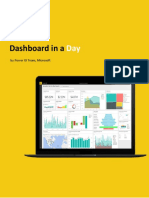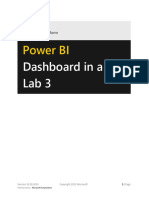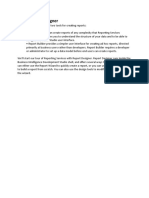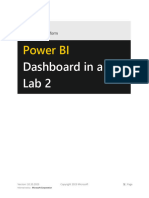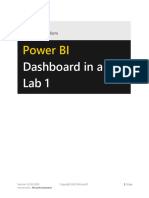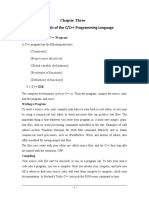Lab 3 - Data Visualization
Uploaded by
Flossy PrestonLab 3 - Data Visualization
Uploaded by
Flossy PrestonPower BI
Dashboard in a Day
Lab 3
Version: 6.30.2022 Copyright 2022 Microsoft 1 |Page
Maintained by: Microsoft Corporation
Contents
Introduction ..................................................................................................................................................... 3
Power BI Desktop ............................................................................................................................................ 4
Power BI Desktop – Data Visualization ........................................................................................................ 4
References ..................................................................................................................................................... 33
Version: 6.30.2022 Copyright 2022 Microsoft 2 |Page
Maintained by: Microsoft Corporation
Introduction
This document is lab three out of five total labs.
Please continue to use your file after completing Lab 2. If you are joining the DIAD at this point or were
unable to complete previous labs, please start this lab with the provided Lab 2 solution.pbix file found in
the Reports folder.
At the end of this lab, you will have completed a full report that is ready to be published to the Power BI
Service. In the report, you will have learned how to do conditional formatting, add a logo to the
manufacturer filter, import a custom visual, and apply a custom theme to the report. By the end of this
lab, you will have also learned how to add bookmarks to tell a story about the report.
The flow of this document includes screenshots to provide a visual aid for the users and a text description
of the steps the user needs to follow. In the screenshots, sections are highlighted with red or orange
boxes to indicate the action or area on which a user needs to focus.
NOTE: This lab uses real, anonymized data provided by ObviEnce, LLC. Visit their site to learn about their
services: www.obvience.com. This data is the property of ObviEnce, LLC and has been shared to
demonstrate Power BI functionality with industry sample data. Any use of this data must include this
attribution to ObviEnce, LLC.
Version: 6.30.2022 Copyright 2022 Microsoft 3 |Page
Maintained by: Microsoft Corporation
Power BI Desktop
Power BI Desktop – Data Visualization
Now that we’ve completed data exploration and visualization in labs one and two, you have good insights
to share with your team. In this section, you create a professional report for the benefit of you and your
entire team.
At the end of this section, you will build a report like the one shown in the screenshot below.
Now let’s get started, we will pick up where we left off at the end of Lab 2.
1. With the Matrix visual selected, navigate to the Values section and click the arrow next to %
Growth.
2. Click Conditional Formatting and then click Background color. The Background color dialog box
opens. This dialog provides options to format the report background color using either rules or
diverging colors.
Version: 6.30.2022 Copyright 2022 Microsoft 4 |Page
Maintained by: Microsoft Corporation
3. Click on the Add a middle color checkbox.
4. Click OK.
Version: 6.30.2022 Copyright 2022 Microsoft 5 |Page
Maintained by: Microsoft Corporation
Note: Conditional formatting can also be based on another column using the Color based on the drop-
down menu.
Initially, we added a filter to load three years of data. Let’s load the complete data now.
5. From the ribbon, click Home and then click Transform Data. The Power Query Editor window
opens.
6. Click the filter button on the Date column.
7. Click Clear filter to remove the 3-year filter.
8. Click Home and then click Close & Apply to load the data.
Version: 6.30.2022 Copyright 2022 Microsoft 6 |Page
Maintained by: Microsoft Corporation
This time all the data will be loaded. It might take a couple of minutes as we are loading approximately
seven million rows.
Make sure the report is filtered by VanArsdel using the Manufacturer slicer. Remove all other filters.
9. Enable drill down mode on the Revenue by Country visual
10. Click Australia to drill down to State.
11. Disable drill mode on the Revenue by Country and State visual
At this point, your report page should look like the screenshot below.
Once data is loaded, notice Revenue by Year visual. You will see columns for years 2014 through 2021.
12. Hover over Manufacturer slicer visual.
13. On the top right corner, click the arrow.
14. Click List.
Version: 6.30.2022 Copyright 2022 Microsoft 7 |Page
Maintained by: Microsoft Corporation
15. In the Visualizations panel, click the paint roller icon. This opens the formatting options available
for a visual.
16. To expand the General section, click Horizontal in the Orientation drop-down menu.
17. Notice the Slicer visual is updated. You can resize the visual, so all the manufacturers are listed
horizontally.
Note: There are other options to change the outline color, weight, and more.
18. Click VanArsdel.
19. Now, collapse the General section.
Note: Notice there is an option to enable the Select All option in the visual. There is also an option to
make the slicer multi-select. Feel free to explore other formatting options.
Now it would be nice to add logos of the manufacturer to the slicer. Let’s do it.
20. From the Fields section, click the Logo field in the Manufacturer table
21. From the ribbon, click Column tools, click Data Category and then click Image URL. Setting the
data category to Image URL helps Power BI understand that it is a URL so it can access the data.
Version: 6.30.2022 Copyright 2022 Microsoft 8 |Page
Maintained by: Microsoft Corporation
22. From the canvas, click the Manufacturer slicer.
23. From the Fields section, drag and drop the Logo from the Manufacturer table to the Field box
replacing the Manufacturer column.
24. Resize the slicer visual as needed.
25. Click the VanArsdel logo to filter all the other visuals.
26. Click the Revenue by Year visual.
Version: 6.30.2022 Copyright 2022 Microsoft 9 |Page
Maintained by: Microsoft Corporation
27. From Visualizations panel, click the Line and clustered column chart to change the visual type.
28. From the Fields section, drag and drop the % Growth field from the Sales table to the Line values.
This provides a representation of the revenue and growth over time.
29. Now let’s click the Revenue Card visual so we can change it to a Gauge visual.
30. From the Visualizations panel, click the Gauge visual.
31. From the Fields section, drag and drop the PY Sales field to the Target value.
Version: 6.30.2022 Copyright 2022 Microsoft 10 |Page
Maintained by: Microsoft Corporation
32. Resize the visual as needed. Now we can compare Revenue with the target.
Now let’s take time to select the colors of the visuals.
33. Click the Gauge visual.
34. From the Visualizations panel, click the paint roller icon.
35. Expand the Data Colors section.
36. Click the arrow next to Fill color.
37. Notice you can pick a color from the default color palette or pick More colors.
Version: 6.30.2022 Copyright 2022 Microsoft 11 |Page
Maintained by: Microsoft Corporation
Let’s check out some of the themes available.
38. From the ribbon, click View, click Themes, and then click Temperature.
Version: 6.30.2022 Copyright 2022 Microsoft 12 |Page
Maintained by: Microsoft Corporation
Notice that the colors on all the visuals are updated. Feel free to try the other out-of-the-box themes.
In our scenario, the Marketing department has provided standard color themes to be used across reports.
We can use the Report Theme feature in Power BI by uploading a theme. The Report Theme requires a
JSON file where the data colors, background, foreground, and a table of accent colors are defined. The
JSON file can be used across all the reports.
39. From the ribbon, click View, click Themes, and then click Browse for themes.
40. A file browser dialog box opens. Navigate to the Data folder then the Theme folder
(/Data/Theme).
41. Click the DIADTheme2 file and then click Open.
Version: 6.30.2022 Copyright 2022 Microsoft 13 |Page
Maintained by: Microsoft Corporation
42. Once the theme is imported, a success dialog box opens. Click Close.
Notice colors on all the visuals are updated. Your report should look like the screenshot at this point. This
theme looks good. Now, most of the visuals are blue, so let’s add some contrast.
Note: Here you can save and add your custom themes.
43. Click the Gauge visual.
44. From the Visualizations panel, click the paint roller icon.
45. Expand the Data colors section.
46. Click the drop-down menu next to Target. Notice the color palette is different now.
Version: 6.30.2022 Copyright 2022 Microsoft 14 |Page
Maintained by: Microsoft Corporation
47. Click the black color. Notice how it changes in the visual.
48. Collapse the Data colors section.
49. Expand the Data Labels section.
50. Change the Text size to 10.
51. Expand the Target section.
52. Change the Text size to 10.
Version: 6.30.2022 Copyright 2022 Microsoft 15 |Page
Maintained by: Microsoft Corporation
53. Click the Matrix visual.
54. Drill up to the Segment level.
55. Click the Revenue by Country and State visual.
56. Drill up to the Country level.
57. From the Visualizations panel, click the paint roller icon.
58. Expand the Columns section, then the Colors section
59. Select a light shade of gray as the Default color.
Version: 6.30.2022 Copyright 2022 Microsoft 16 |Page
Maintained by: Microsoft Corporation
60. Turn on the Data labels.
61. Expand the Values section
62. Change the Display units to Millions.
Version: 6.30.2022 Copyright 2022 Microsoft 17 |Page
Maintained by: Microsoft Corporation
Notice that there a lot of formatting options. For example, a visual title can be changed and formatted, or
you can add a border and background to the visual. Feel free to explore the options.
63. Let’s move to another visual, click the Revenue and % Growth by Year visual.
64. From the Visualizations panel, click the paint roller icon.
65. Expand the Columns section.
66. Expand Colors section
67. Select a light shade of gray as the Default color.
68. Expand the Lines section
69. Expand Colors
70. Set default color to black
Version: 6.30.2022 Copyright 2022 Microsoft 18 |Page
Maintained by: Microsoft Corporation
Now let’s add a report title.
71. From the ribbon, click Home and then click Text box. Notice a text box visual is added.
72. Resize the visual as needed.
73. Enter Manufacturer Analysis in the text box.
74. Highlight Manufacturer Analysis to format the text.
75. Select Segoe (Bold) as the font.
76. Select 36 as the font size.
77. Resize the text box as needed.
78. Notice the additional formatting option that have been added highlighted in black (superscript,
subscript, and bulleted lists)
Version: 6.30.2022 Copyright 2022 Microsoft 19 |Page
Maintained by: Microsoft Corporation
79. From the ribbon, click View.
80. Click the checkbox next to Show Gridlines and Snap to Grid. This will help with aligning the
visuals.
81. Uncheck the Show Gridlines and Snap to Grid options to disable these features.
82. Right-click the page name in the lower-left corner and then click Rename Page.
83. Rename the page to Manufacturer.
Version: 6.30.2022 Copyright 2022 Microsoft 20 |Page
Maintained by: Microsoft Corporation
We can also use a background image to format the reports. Let’s try it.
84. Click the white space in the canvas.
85. From the Visualizations panel, click the paint roller icon.
86. Expand the Canvas Background section.
87. Click the Browse Image button.
88. A File browser dialog box opens. Browse to the DIAD folder then the Data folder (/DIAD/Data).
89. Click the Background file.
90. Click Open.
91. Slide Transparency slider to 0%.
Notice we have a template which has a place for header and slots for images.
92. Resize and arrange the visuals as shown in the screenshot
Version: 6.30.2022 Copyright 2022 Microsoft 21 |Page
Maintained by: Microsoft Corporation
Now let’s add a logo.
93. From the ribbon, click Insert and then click Image
94. The File browser dialog opens. Browse to the DIAD folder then the Data folder (/DIAD/Data).
95. Change the file type to All files(*).
96. Click the VanArsdel_Logo file.
97. Click Open.
Version: 6.30.2022 Copyright 2022 Microsoft 22 |Page
Maintained by: Microsoft Corporation
98. Resize the visual as needed.
99. Drag the visual to the top left corner of the page.
Note: The logo is transparent. You need to place it on the blue background to see it.
Now let’s change the font color of the report title.
100. Highlight Manufacturer Analysis.
101. Click the arrow next to the A for the font color. Select the white color.
102. Change the size of the font to 24
103. Click on Effects in the Visualizations pane and set Transparency to 100%
Version: 6.30.2022 Copyright 2022 Microsoft 23 |Page
Maintained by: Microsoft Corporation
Now let’s add a smart narrative visual to our report.
104. First resize the Revenue by Year visual
105. Add a smart narrative visual to the canvas
Version: 6.30.2022 Copyright 2022 Microsoft 24 |Page
Maintained by: Microsoft Corporation
Out of the box, Power BI has a large selection of visuals. However, there may be a use-case when you
need a custom visual. To meet this requirement, the visualization engine is open-sourced. The Power BI
community contributes visuals in the marketplace. You can add and use these visuals in your reports.
There is also an option to create your own visual and import it into Power BI Desktop.
Now let’s add a custom visual.
106. From Visualizations section, click the ellipse in the last row of visuals.
107. Click Get more visuals.
Version: 6.30.2022 Copyright 2022 Microsoft 25 |Page
Maintained by: Microsoft Corporation
108. Type play axis in the search box and click the Search icon.
109. Click the Add next to the Play Axis (Dynamic Slicer).
Note: Notice the checkmark in the blue star. This image is used to identify certified custom visuals. Custom
visuals that meet Power BI teams coding requirements are certified. Certified custom visuals support
features like export to PowerPoint and the ability to display in subscription emails which are not
supported by non-certified custom visuals.
110. The import custom visual dialog opens. Click Get it now
Version: 6.30.2022 Copyright 2022 Microsoft 26 |Page
Maintained by: Microsoft Corporation
111. Notice a new visual is added to the list of available visuals.
112. Click on the white space in the canvas.
113. From the Visualizations section, click the newly imported Play Axis visual.
114. From the Fields section, click the checkbox next to the Date field in the Date table.
115. From the Visualizations panel, click the paint roller icon.
116. Expand the Colors section.
117. Enable the Show all option.
118. Resize and position the visual as shown in the screenshot below.
Version: 6.30.2022 Copyright 2022 Microsoft 27 |Page
Maintained by: Microsoft Corporation
Now that we have a report ready, let’s use Bookmarks to tell the story we discovered. Bookmarks capture
the currently configured view of a report page, including filtering and the state of visuals which helps to
make it easier to present the story.
119. From the ribbon, click View.
120. Click the Bookmarks button to enable Bookmarks. The Bookmarks pane opens.
121. Click on Add in the Bookmarks pane. This will add the current state of the visual to the
bookmark.
122. Click the ellipse next to the newly created Bookmark 1.
123. Click Rename and change the name to Initial State.
124. In the Revenue by Country visual, click the USA column.
125. Hover over the Revenue by Country visual and click the ellipse on the top right corner.
126. Click Spotlight.
127. In the Bookmarks pane, click Add. This will add a new bookmark with the current state of
the report.
128. Change the bookmark name to USA Revenue
129. Click on the canvas.
Version: 6.30.2022 Copyright 2022 Microsoft 28 |Page
Maintained by: Microsoft Corporation
130. Click Australia in the Revenue by Country visual.
131. In the Bookmarks pane, click Add. This will add a new bookmark with the current state of
the report.
132. Change the bookmark name to Australia Revenue
133. From the Bookmarks pane, click View. You are now in Bookmarks slide show mode. You
will be in the first bookmark, which we called Initial State. Notice on the bottom of the report
pane there is an option to navigate between bookmarks.
134. You can use the arrows to navigate between bookmarks and tell your story.
135. From the Bookmarks pane, click Exit to exit the Bookmarks slide show mode.
If time permits, feel free to explore other options available with Bookmarks, such as Selected Visuals, as
you continue to build your story.
136. From the ribbon, click View.
137. Uncheck the Bookmarks Pane.
138. Collapse the Visualizations and Filters pane by clicking on the arrows
Version: 6.30.2022 Copyright 2022 Microsoft 29 |Page
Maintained by: Microsoft Corporation
Now let’s add bookmark navigator buttons to the canvas
1. From the ribbon, click the Insert ribbon.
2. Click on Button and select Navigator -> Bookmark navigator
3. Arrange the Bookmark navigator to fit on the page as shown below
4. Click on the heading Fill and change the Fill color to a light blue and set Transparency to 40
Version: 6.30.2022 Copyright 2022 Microsoft 30 |Page
Maintained by: Microsoft Corporation
5. Click on the heading Shape, there is a long list of shapes to choose from, let’s pick Rounded
Rectangle
Version: 6.30.2022 Copyright 2022 Microsoft 31 |Page
Maintained by: Microsoft Corporation
Feel free to test out the new functionality.
Your report should look as shown in the figure below. Now let’s finish up by saving the file.
6. Click File and then click Save.
You have built your first report!
You have successfully completed the hands-on lab by creating a report to share to your team. The next lab
covers creating a dashboard from this report to share with your team. You have seen an overview of the
functionality in Power BI Desktop. There are many more features for you to explore with your data!
Version: 6.30.2022 Copyright 2022 Microsoft 32 |Page
Maintained by: Microsoft Corporation
References
Dashboard in a Day introduces you to some of the key functions available in Power BI. In the ribbon of the
Power BI Desktop, the Help section has links to some great resources.
Here are a few more resources that will help you with your next steps with Power BI.
• Getting started: http://powerbi.com
• Power BI Desktop: https://powerbi.microsoft.com/desktop
• Power BI Mobile: https://powerbi.microsoft.com/mobile
• Community site https://community.powerbi.com/
• Power BI Getting started support page:
https://support.powerbi.com/knowledgebase/articles/430814-get-started-with-power-bi
• Support site https://support.powerbi.com/
• Feature requests https://ideas.powerbi.com/forums/265200-power-bi-ideas
• New ideas for using Power BI https://aka.ms/PBI_Comm_Ideas
• Power BI Courses http://aka.ms/pbi-create-reports
• Power Platform https://powerplatform.microsoft.com/en-us/instructor-led-training/
• Power Apps Business Apps | Microsoft Power Apps
• Power Automate Power Automate | Microsoft Power Platform
• Dataverse What is Microsoft Dataverse? - Power Apps | Microsoft Docs
© 2022 Microsoft Corporation. All rights reserved.
By using this demo/lab, you agree to the following terms:
The technology/functionality described in this demo/lab is provided by Microsoft Corporation for purposes of
obtaining your feedback and to provide you with a learning experience. You may only use the demo/lab to evaluate
such technology features and functionality and provide feedback to Microsoft. You may not use it for any other
purpose. You may not modify, copy, distribute, transmit, display, perform, reproduce, publish, license, create
derivative works from, transfer, or sell this demo/lab or any portion thereof.
COPYING OR REPRODUCTION OF THE DEMO/LAB (OR ANY PORTION OF IT) TO ANY OTHER SERVER OR LOCATION
FOR FURTHER REPRODUCTION OR REDISTRIBUTION IS EXPRESSLY PROHIBITED.
Version: 6.30.2022 Copyright 2022 Microsoft 33 |Page
Maintained by: Microsoft Corporation
THIS DEMO/LAB PROVIDES CERTAIN SOFTWARE TECHNOLOGY/PRODUCT FEATURES AND FUNCTIONALITY,
INCLUDING POTENTIAL NEW FEATURES AND CONCEPTS, IN A SIMULATED ENVIRONMENT WITHOUT COMPLEX SET-
UP OR INSTALLATION FOR THE PURPOSE DESCRIBED ABOVE. THE TECHNOLOGY/CONCEPTS REPRESENTED IN THIS
DEMO/LAB MAY NOT REPRESENT FULL-FEATURE FUNCTIONALITY AND MAY NOT WORK THE WAY A FINAL VERSION
MAY WORK. WE ALSO MAY NOT RELEASE A FINAL VERSION OF SUCH FEATURES OR CONCEPTS. YOUR EXPERIENCE
WITH USING SUCH FEATURES AND FUNCTIONALITY IN A PHYSICAL ENVIRONMENT MAY ALSO BE DIFFERENT.
FEEDBACK. If you give feedback about the technology features, functionality and/or concepts described in this
demo/lab to Microsoft, you give to Microsoft, without charge, the right to use, share and commercialize your
feedback in any way and for any purpose. You also give to third parties, without charge, any patent rights needed for
their products, technologies and services to use or interface with any specific parts of a Microsoft software or service
that includes the feedback. You will not give feedback that is subject to a license that requires Microsoft to license its
software or documentation to third parties because we include your feedback in them. These rights survive this
agreement.
MICROSOFT CORPORATION HEREBY DISCLAIMS ALL WARRANTIES AND CONDITIONS WITH REGARD TO THE
DEMO/LAB, INCLUDING ALL WARRANTIES AND CONDITIONS OF MERCHANTABILITY, WHETHER EXPRESS, IMPLIED OR
STATUTORY, FITNESS FOR A PARTICULAR PURPOSE, TITLE AND NON-INFRINGEMENT. MICROSOFT DOES NOT MAKE
ANY ASSURANCES OR REPRESENTATIONS WITH REGARD TO THE ACCURACY OF THE RESULTS, OUTPUT THAT DERIVES
FROM USE OF DEMO/ LAB, OR SUITABILITY OF THE INFORMATION CONTAINED IN THE DEMO/LAB FOR ANY
PURPOSE.
DISCLAIMER
This demo/lab contains only a portion of new features and enhancements in Microsoft Power BI. Some of the
features might change in future releases of the product. In this demo/lab, you will learn about some, but not all, new
features.
Version: 6.30.2022 Copyright 2022 Microsoft 34 |Page
Maintained by: Microsoft Corporation
You might also like
- Lab 1 - Accessing and Preparing Data StepsNo ratings yetLab 1 - Accessing and Preparing Data Steps28 pages
- Lab 4 - Publishing and Accessing ReportsNo ratings yetLab 4 - Publishing and Accessing Reports32 pages
- Lab 4 - Publishing and Accessing ReportsNo ratings yetLab 4 - Publishing and Accessing Reports34 pages
- Lab 4 - Publishing and Accessing Reports A4No ratings yetLab 4 - Publishing and Accessing Reports A429 pages
- Lab 2 - Data Modeling and Exploration A4No ratings yetLab 2 - Data Modeling and Exploration A444 pages
- Lab 1 - Accessing and Preparing Data A4No ratings yetLab 1 - Accessing and Preparing Data A433 pages
- Lab 4 - Publishing and Accessing ReportsNo ratings yetLab 4 - Publishing and Accessing Reports40 pages
- Lab 4 - Publishing and Accessing ReportsNo ratings yetLab 4 - Publishing and Accessing Reports28 pages
- Lab 4 - Publishing and Accessing ReportsNo ratings yetLab 4 - Publishing and Accessing Reports33 pages
- Cognos Analytics - Getting Started With ReportingNo ratings yetCognos Analytics - Getting Started With Reporting43 pages
- Lab 0 - Prerequisites and Document StructureNo ratings yetLab 0 - Prerequisites and Document Structure6 pages
- Lab 0 - Prerequisites and Document StructureNo ratings yetLab 0 - Prerequisites and Document Structure5 pages
- Lab 0 - Prerequisites and Document StructureNo ratings yetLab 0 - Prerequisites and Document Structure5 pages
- Cognos 8 Business Intelligence (C8 BI) Framework ManagerNo ratings yetCognos 8 Business Intelligence (C8 BI) Framework Manager25 pages
- Lab 3.1 Create A Report Using Cube Data: ScenarioNo ratings yetLab 3.1 Create A Report Using Cube Data: Scenario10 pages
- Lab 0 - Prerequisites and Document Structure A4No ratings yetLab 0 - Prerequisites and Document Structure A45 pages
- Cognos Analytics - Getting Started With DashboardingNo ratings yetCognos Analytics - Getting Started With Dashboarding60 pages
- Lab 4 - Publishing and Accessing ReportsNo ratings yetLab 4 - Publishing and Accessing Reports31 pages
- 4.2 Build A Model With IBM Cognos Framework Manager: 4.2.1 Import Metadata Using Model Design AcceleratorNo ratings yet4.2 Build A Model With IBM Cognos Framework Manager: 4.2.1 Import Metadata Using Model Design Accelerator3 pages
- Lab 0 - Prerequisites and Document StructureNo ratings yetLab 0 - Prerequisites and Document Structure5 pages
- Mastering OBIEE11g Dashboard and Reporting Guide100% (1)Mastering OBIEE11g Dashboard and Reporting Guide142 pages
- Lenovo - SAP HANA Backup Guide-1.12.121-16 - 33-EndNo ratings yetLenovo - SAP HANA Backup Guide-1.12.121-16 - 33-End7 pages
- Identify How to Perform a Safety Check within a Google Chrome BrowserNo ratings yetIdentify How to Perform a Safety Check within a Google Chrome Browser13 pages
- Chapter Three Fundamentals of The C/C++ Programming LanguageNo ratings yetChapter Three Fundamentals of The C/C++ Programming Language23 pages
- Make Up - V - VII - Sem B.E. Time Table - 2021-22No ratings yetMake Up - V - VII - Sem B.E. Time Table - 2021-223 pages
- Information Security Manual Standard 27002 IsoNo ratings yetInformation Security Manual Standard 27002 Iso129 pages
- Exam AZ-204: Developing Solutions For Microsoft Azure - Skills MeasuredNo ratings yetExam AZ-204: Developing Solutions For Microsoft Azure - Skills Measured7 pages
- VTU Exam Question Paper With Solution of 18MCA51 Programming Using C#.NET Jan-2021-Ms Uma BNo ratings yetVTU Exam Question Paper With Solution of 18MCA51 Programming Using C#.NET Jan-2021-Ms Uma B37 pages
- Ellipse: Superior Planning, Management and Optimization of Next-Generation Backhaul NetworksNo ratings yetEllipse: Superior Planning, Management and Optimization of Next-Generation Backhaul Networks4 pages
- Chapters of Linux Gym: (Green Means Completed) : The Filesystem 1No ratings yetChapters of Linux Gym: (Green Means Completed) : The Filesystem 13 pages
- Link Aggregation Control Protocol On Software Defined NetworkNo ratings yetLink Aggregation Control Protocol On Software Defined Network7 pages
- Role of Information Systems in Business Today: Globalization Challenges and OpportunitiesNo ratings yetRole of Information Systems in Business Today: Globalization Challenges and Opportunities14 pages
- Human-Rights - Project Scenario 2022-2023No ratings yetHuman-Rights - Project Scenario 2022-20237 pages
- LESSON 4 - Maintenance and TroubleshootingNo ratings yetLESSON 4 - Maintenance and Troubleshooting10 pages
- Design of Tension Leg Platforms: A Knowledge Base Approach To TheNo ratings yetDesign of Tension Leg Platforms: A Knowledge Base Approach To The76 pages
- Autodesk Maya 2018: A Comprehensive Guide, 10th EditionFrom EverandAutodesk Maya 2018: A Comprehensive Guide, 10th Edition
- Cognos 8 Business Intelligence (C8 BI) Framework ManagerCognos 8 Business Intelligence (C8 BI) Framework Manager
- Cognos Analytics - Getting Started With DashboardingCognos Analytics - Getting Started With Dashboarding
- 4.2 Build A Model With IBM Cognos Framework Manager: 4.2.1 Import Metadata Using Model Design Accelerator4.2 Build A Model With IBM Cognos Framework Manager: 4.2.1 Import Metadata Using Model Design Accelerator
- Lenovo - SAP HANA Backup Guide-1.12.121-16 - 33-EndLenovo - SAP HANA Backup Guide-1.12.121-16 - 33-End
- Identify How to Perform a Safety Check within a Google Chrome BrowserIdentify How to Perform a Safety Check within a Google Chrome Browser
- Chapter Three Fundamentals of The C/C++ Programming LanguageChapter Three Fundamentals of The C/C++ Programming Language
- Exam AZ-204: Developing Solutions For Microsoft Azure - Skills MeasuredExam AZ-204: Developing Solutions For Microsoft Azure - Skills Measured
- VTU Exam Question Paper With Solution of 18MCA51 Programming Using C#.NET Jan-2021-Ms Uma BVTU Exam Question Paper With Solution of 18MCA51 Programming Using C#.NET Jan-2021-Ms Uma B
- Ellipse: Superior Planning, Management and Optimization of Next-Generation Backhaul NetworksEllipse: Superior Planning, Management and Optimization of Next-Generation Backhaul Networks
- Chapters of Linux Gym: (Green Means Completed) : The Filesystem 1Chapters of Linux Gym: (Green Means Completed) : The Filesystem 1
- Link Aggregation Control Protocol On Software Defined NetworkLink Aggregation Control Protocol On Software Defined Network
- Role of Information Systems in Business Today: Globalization Challenges and OpportunitiesRole of Information Systems in Business Today: Globalization Challenges and Opportunities
- Design of Tension Leg Platforms: A Knowledge Base Approach To TheDesign of Tension Leg Platforms: A Knowledge Base Approach To The



